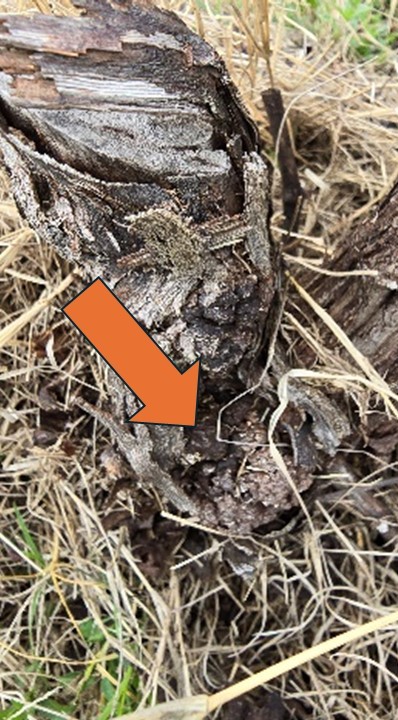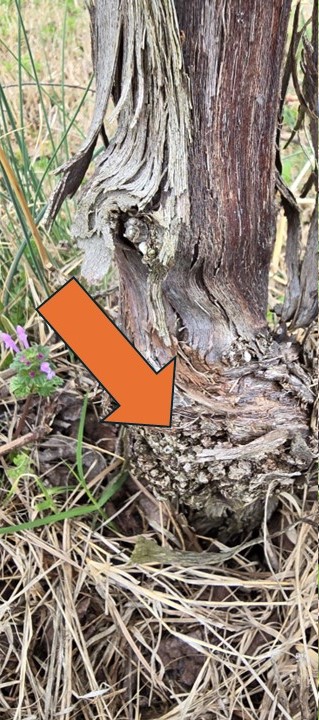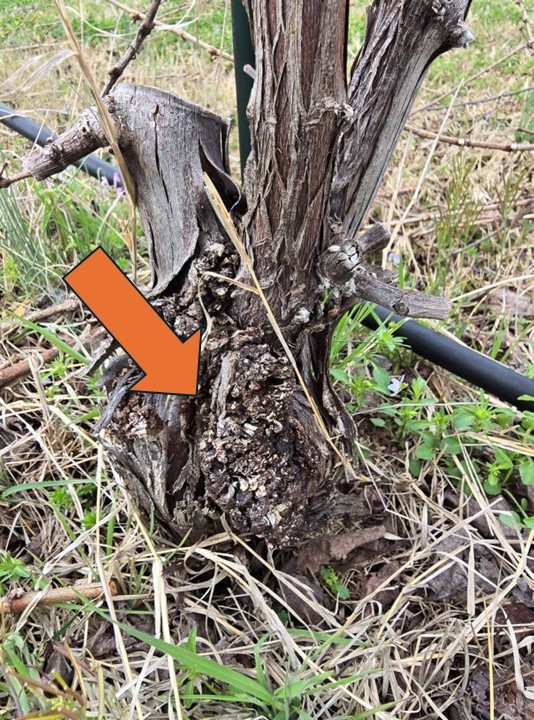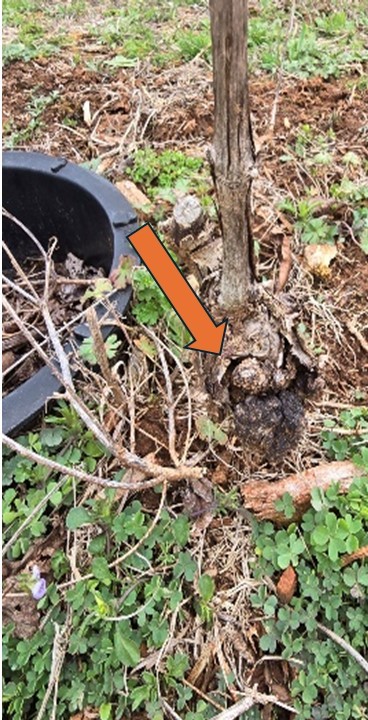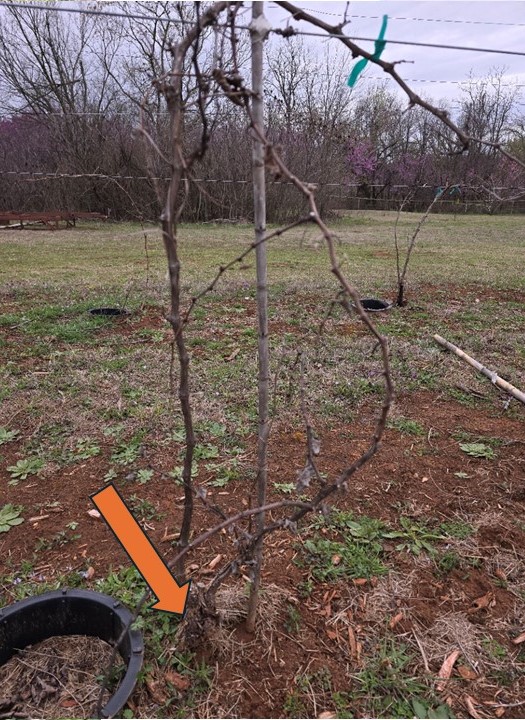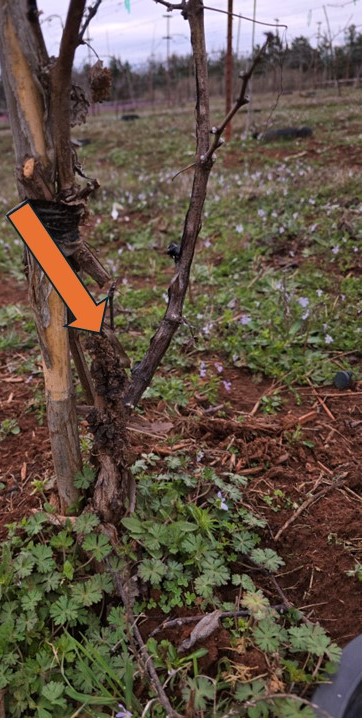Managing the Widespread Crown Gall Disease in Oklahoma Vineyards - Sept. 17, 2024
The ongoing 2024 survey identifies crown gall in multiple vineyards on various grape cultivars across Oklahoma. Crown gall is regarded as the second most important grapevine disease in the state, after grape black rot disease (Olson, 2017 EPP-7669). The disease appears as galls on the crown of young and established vines (Figures 1 and 2). Crown gall of grapes is predominately caused by the bacterium Allorhizobium vitis (previously Agrobacterium vitis). The other widely known crown gall-causing bacterium, A. tumefaciens, is often isolated from galls on grapes but the association with the disease is at a much lower frequency than A. vitis. Infection occurs majorly at wound sites, freeze injuries and graft unions.
Crown gall is a systemic and chronic disease that causes decreased yields and early grapevine death (Burr, 2004). The disease cause necrosis on vines which can in turn affect root development and inhibit graft take. Virulent A. vitis strains harbor tumor-inducing plasmids that carry genes (called oncogenes) that induce the formation of crown galls. Expression of these genes in transformed host cells induces unregulated cell proliferation which causes several metabolic and physiological changes. The crown gall harbors mechanisms that produce chemicals named opines that sustain A. vitis.
Figure 1.1. Crown gall symptoms on the base of a young, trained grapevine in a vineyard in Oklahoma in 2024.
Figure 1.2. Crown gall symptoms near the roots on a young, trained grapevine in a vineyard in Oklahoma in 2024.
Figure 1.3. Crown gall symptoms on young, trained grapevines as seen in a vineyard in Oklahoma in 2024.
Figure 2.1. Crown gall symptoms on older grapevines as seen in a vineyard in Oklahoma in 2024.
Figure 2.2. Crown gall symptoms on small, older grapevines as seen in a vineyard in Oklahoma in 2024.
Figure 2.3. Crown gall symptoms on the bases of older grapevines as seen in a vineyard in Oklahoma in 2024.
Crown gall can be soil borne, adding another layer of complexity to disease management. Although crown gall can persist for a long time in grape vineyards, growers can take several steps to limit the impact of the disease.
| Typical growers' concern | Advisory |
|---|---|
| Does the planned vineyard site has a known history of crown gall? | If yes, soil tests before establishing the vineyard should include testing for the crown gall pathogen, Allorhizobium vitis.Generally, it is advisable to allow for 2 years before using the same site for grape production. |
| What should I emphasize when ordering vines from commercial outlets? | Make sure to order disease-free vines and resistant rootstocks. |
| Are there cultivars that are most susceptible? | Susceptible: 1103P, Highly Susceptible: 110R, Ramsey, K5140 |
| What are the available resistant cultivars? | Highly resistant: 775P, R. gloire; Resistant: 3309C,101-14Mgt, Freedom, Harmony, Kober 5BB. |
| Are resistant varieties free of A. vitis? | Not necessarily. Even the highly resistant wild grapes, V. riparia can carry A. vitis internally. |
| My recently established vines are showing symptoms of crown gall disease. What can I do? | If possible, plan to replace the vines with new stands as immediately as you can. Destroy infected vines. Contact your local extension agent. |
| Can my grapevine still produce grapes with crown gall infection? | It generally depends on the stage of infection. Young vines may die. More established vines can vary in their ability to produce grapes. |
Other management decisions that can help manage crown gall disease include:
-
Site selection. In addition to selecting sites free of vitis, efforts should be invested in selecting sites that have good air flow and well-drained soil to prevent freeze injury.
-
Hilling up. Mounding soil over the graft union before the onset of extreme cold events have been reported to ensure survival of scion buds for trunk renewal.
-
Establishing multiple trunks. Having multiple trunks makes it easier to remove and replace galled trunks without losing the production year.
-
Take care to monitor vineyard health on a regular basis. Replace trunks and vines that show disease symptoms.
-
Hot water treatments at 50 to 53 0C (122-127 degree Fahrenheit) for 30 minutes has been shown to reduce >90% of pathogen in cuttings but this does not eradicate the pathogen.
-
Chemical options: there are currently no synthetic chemical options for managing crown galls. However, suggested biocontrol formulations include Gallex and GALLTROL-A, the former showing better results than the latter. However, vitis still persists internally in vines.
References
Burr, T.J. (2004). Grape Crown Gall Biology and Strategies for Control. Foundation Plant Services Grape Program Newsletter.
Olson, J. (2017) Crown Gall of Grape. EPP-7669.

